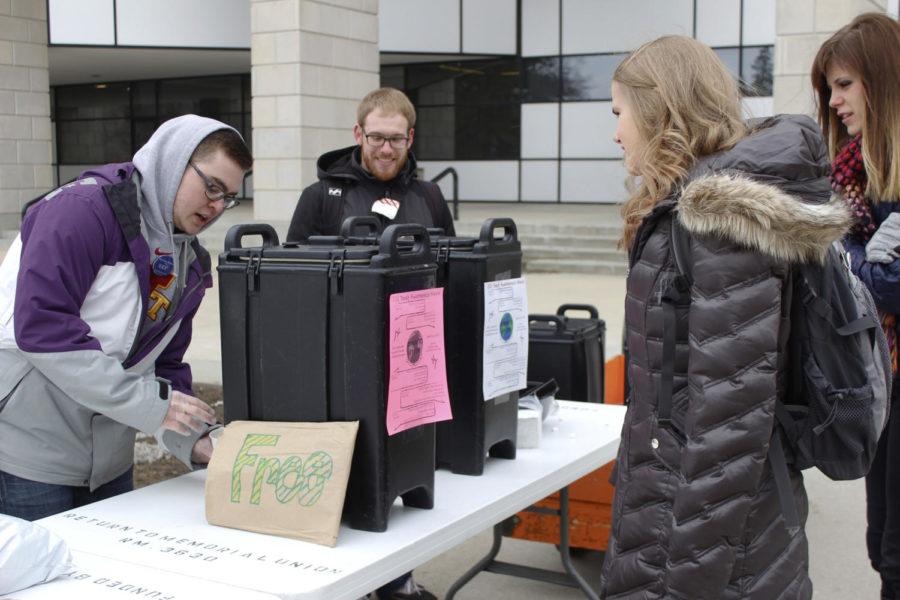Iowa State professors present on ASL and Deaf culture
Jessica Darland/Iowa State Daily
Court Mac Gregor, then-sophomore in kinesiology, and Joey Foss, then-senior in aerospace science, handed out free hot chocolate in front of the library March 2, 2015, to promote Deaf Awareness Week. They were also selling bracelets and buttons to get the word out. Other events happening included learning basic American Sign Language vocabulary, a pizza fundraiser and a showing of the movie, “The Hammer.”
October 5, 2019
As 11 a.m. approached Friday morning at Memorial Union, the large semicircle of chairs in the Gallery were completely filled by students, teachers and employees of the school. Dina Toulan, lecturer of American Sign Language (ASL) in the world languages and cultures department, used the semicircle setup in her classroom so that everyone was able to clearly see her.
Toulan and Rachel Johnson, assistant teaching professor of ASL for world languages and cultures, along with Jeff Reese, an interpreter and director of Life Interpretation, Inc., gave an informative and interactive presentation on ASL and Deaf culture. They allowed the audience to ask questions through text messages to an online platform called Slido.
Johnson began by pointing out interesting facts about Deaf individuals, such as they are statistically better drivers than those who are not Deaf. About thirty percent of those in the Deaf community have issues with balance, and ninety percent are born to hearing parents, though a very small percentage of those parents actually learn sign language along with their child.
Johnson emphasized the importance of information sharing among Deaf people, as well as the distinction of using a capitalized versus a lowercase “D” in the word “deaf.” She likened it to calling someone an “American.” Capitalizing the “D” is part of how the Deaf community identifies itself, and using a lowercase “d” is just a descriptor. Deaf+ is another term used to describe individuals who are deaf coupled with another or multiple disabilities.
For the next part of the session, the room was quiet save the occasional slaps or taps from the audience copying Toulan’s and Johnson’s hand signs. They taught the alphabet, greetings such as “how are you,” emergency signals and other basic communicative phrases.
After learning these signs, the questions sent in by attendees were addressed and discussed.
One question asked about hand dominance, and if it matters if they are left-handed. Toulan said that they should use their dominant hand for the movement, and it ultimately does not matter which hand you use.
Another asked about the importance of facial expressions in sign language. Toulan animatedly said, “Facial expressions are critical in sign language. Just like you use your voice and tones of your voice to accentuate your mood or feelings… I have to match the sign I’m making. Expressions have to match.”
Johnson discussed the variance of regional sign languages and how she had to get used to the Iowa way to sign words like “truck” and “favorite” that were different from how she learned them. She also addressed a question about Deaf poetry, which is a complicated but artistic form of signage with its own rules and visual rhythms.
Another attendee asked about the prevalence of music for Deaf people. Not everyone in the Deaf community is completely deaf, and some do enjoy music through a number of systems and devices that assist with amplifying sound.
One of the final questions of the day popped up on the screen: What can we do, as those who can hear, to make the lives of Deaf people easier?
“Learn American Sign Language! […] but you can use gestures; don’t be afraid to gesture to get your point across,” Toulan said. “There are a lot of funny stories I can share, you know […] right now, they’re doing a lot of research on what’s called ‘Deaf anxiety,’ worrying about being able to understand and being understood, sort of an environmental anxiety. So when I go into a store, like a clothing store, and they’re asking if I need help, I have to look around when I first begin, just to say ‘no, no, no, I’m not ignoring you, I don’t need help, I’m good.’ I don’t just go in and shop, I’m always paranoid someone is talking to me… but, learning ASL, gesturing a lot, you know, kind of meet us halfway, essentially.”
The last sign of the day that the audience learned was created by none other than Iowa State’s Deaf community: the sign for “Cyclones.”
The next Brown Bag Series session for “ASL: Deaf Culture and Language” will not be until Oct. 18 due to a cancellation of the Oct. 11 session.
Toulan and Johnson teach ASL I through IV, along with a few courses in Deaf culture and history. There will be availability of online classes for ASL I and II beginning in the fall of 2020.







